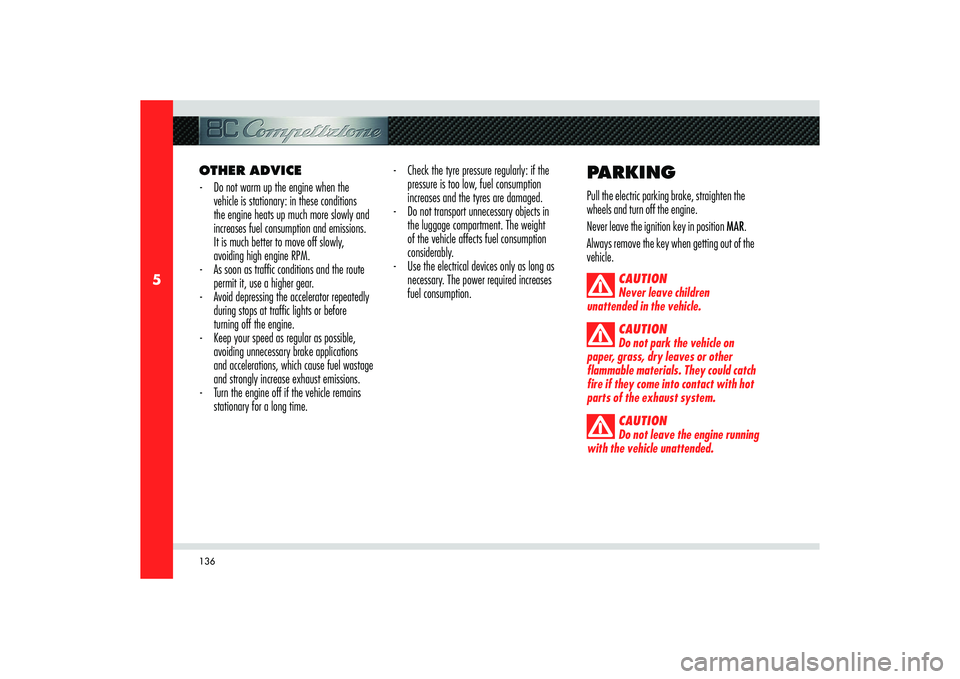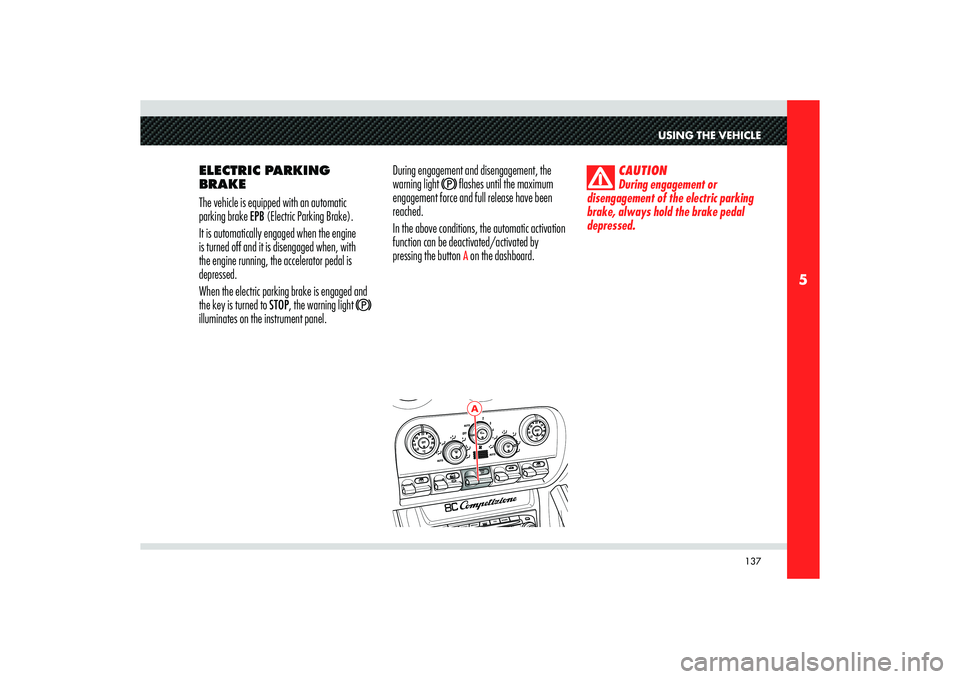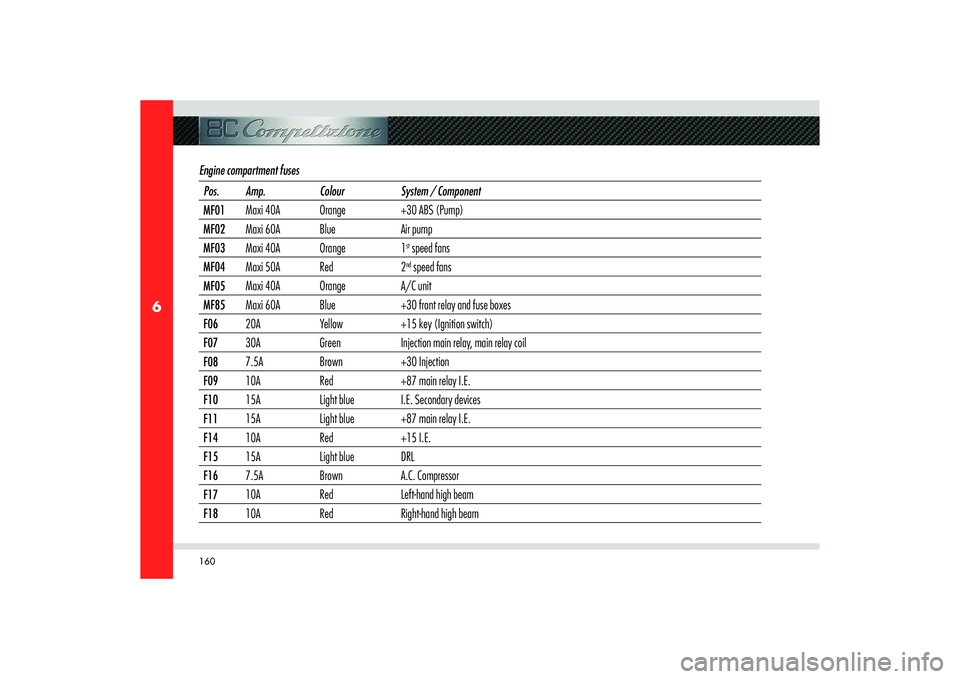key Alfa Romeo 8C 2007 Owner handbook (in English)
[x] Cancel search | Manufacturer: ALFA ROMEO, Model Year: 2007, Model line: 8C, Model: Alfa Romeo 8C 2007Pages: 223, PDF Size: 14.35 MB
Page 123 of 223

121
5
USING THE VEHICLE
REQUESTING
NEUTRAL (N)
If necessary, neutral (N) can be requested at any
speed.
If you then operate the UP paddle, the system
will engage a gear suited to the vehicle speed.
STOPPING THE VEHICLE
When the vehicle stops, the system
automatically engages 1
st gear (unless N has
already bee requested).
With the vehicle stationary and the engine
running, hold the brake pedal depressed until
you are ready to start off again. TURNING OFF
THE ENGINE AND
DEACTIVATING THE
SYSTEM
The engine can only be turned off with the
gearbox in 1
st, or reverse gear R.
If the gear is in neutral and the key is turned
from MAR to position STOP, the display remains
on for a few seconds showing the letter (N)
flashing and activating the acoustic signal.
For safety reasons, to avoid undesired and
sudden vehicle movements:
CAUTION
Never leave the vehicle with
the gear in neutral (N), but engage
1
st or reverse gear and check that the
parking brake has been engaged. Do
not leave the vehicle with the engine
running.CAUTION
Do not remove the key when
the vehicle is moving! The system (and
thus the display) would remain active
but malfunctioning, until the vehicle
stops; in addition, the steering wheel
would lock automatically at the first
turn of the wheel.
In this case, the failure symbol
will
illuminate and, before starting-off again, the
system must be turned off and the “system start-
up” phase repeated.
In any event, it is best to:
- Turn off the engine and the system holding
the brake pedal depressed.
- Do not request a gearshift while the system
is turning off.
Page 128 of 223

126
5
Engine control system (EOBD)
The EOBD (European On Board Diagnosis)
system fitted on the vehicle is compliant with the
2003/76B/EC Directive (EURO 4).
This system continuously monitors the
components of the vehicle related to emissions;
it also indicates, when the warning light
illuminates on the instrument panel, that the
components in question are in poor condition.
The objective is the following:
- monitor the system effi ciency
- indicate when a problem causes an
increase in emissions exceeding the limits
established by European regulations
- indicate the need for replacement of worn
components.In addition, the system includes a diagnostics
connector that can be interfaced with suitable
instruments. This makes it possible to read the
error codes stored in the control unit, together
with a set of specific parameters for engine
operation diagnostics.
WARNING: If when turning the ignition key
to MARthe warning light
does not
illuminate or if it illuminates while driving,
contact an Authorised Service Centre of the
Manufacturer’s Network as soon as possible.
WARNING: After correcting the malfunction, the
entire system must be tested by the personnel
of an Authorised Service Centre of the
Manufacturer’s Network that must perform
tests on the bench and, if necessary, the road
test the vehicle: this might require travelling long
distances.
CONSTANT SPEED
REGULATOR (CRUISE CONTROL)GENERAL
The Cruise Control function allows the driver
to maintain the desired vehicle speed constant
without pressing the accelerator pedal. This
reduces driver fatigue on highways, especially
long trips, as the set speed is automatically
maintained.WARNING: The device can only be activated at
speeds exceeding 30 km/h and it deactivates
automatically when the brake pedal is
depressed.
Page 129 of 223

127
5
A
B
C
USING THE VEHICLE
CAUTION
Cruise Control must only
be activated when traffic and the
route permit a constant speed to be
maintained safely, for a sufficiently
long distance.
CONTROLS
The Cruise Control function is controlled by
means of the switch
A, the dial
B and the button
C (RCL).
Switch
A can be set to two positions:
- OFF the device is deactivated;
- ON the device is active. When the device
is activated, the symbol
illuminates on
the instrument panel display.The dial
B is used to store and maintain the
vehicle speed, or to increase or decrease the
speed stored.
Rotate the dial
B to position (+) to save the
speed reached or to increase the speed stored.
Rotate the dial B to position (–) to decrease the
stored speed.
Each turn of the dial
B increases or decreases the
speed by about 1 km/h. Rotate and hold the
dial to vary the speed continuously. When a new
speed is reached, it will automatically remain
constant.
Button
C (RCL) allows you to reset the stored
speed.
WARNING: When the ignition key is turned to
position STOP or the switch A to position OFF,
the stored speed is deleted and the system
deactivated.STORING A SPEED
Set the switch
A to ON and bring the vehicle up
to the desired speed. Rotate the dial
B to (+)
for at least three seconds, then release it. The
vehicle speed is saved and the accelerator pedal
can then be released.
The vehicle will proceed at the constant speed
stored in the memory until the brake pedal is
pressed.
If necessary, (for example, to pass another
vehicle), you can accelerate by simply pressing
the accelerator pedal. Afterwards, when you
release the accelerator pedal, the vehicle will
return to the speed saved previously.
Page 136 of 223

134
5
Sound the vehicle horn rhythmically if you hear
another vehicle approaching.
- When you get out of the vehicle, put on the
high-visibility vest.DRIVING IN THE
MOUNTAINS
On downhill roads, use the engine brake,
engaging low gears so as not to overheat the
brakes.
- Never coast downhill with the engine off or
in neutral, and never with the ignition key
removed.
- Drive at a moderate speed and avoid
“cutting” corners.
- Remember that passing other vehicles when
driving uphill is slower and thus requires
more free distance on the road. If you are
being overtaken on a hill, slow down and
allow the other vehicle to pass. DRIVING ON SNOW OR
ICE
Below is some general advice for driving in these
conditions:
- Keep a very moderate speed.
- Fit snow chains or specifi c tyres if the road
is covered with snow: see the chapters
“Snow chains” and “Winter tyres” in this
section.
- Mainly use the engine brake and avoid
sharp braking.
- We recommend that you activate “Low
grip” mode (see page 122).
- Avoid sudden acceleration and sharp
changes in direction.
- During the winter season, even apparently
dry roads can have icy sections. Be careful
when crossing bridges, viaducts and roads
that have little exposure to the sun and are
bordered by trees and rocks. They may be
icy.
- Keep a safety distance from the vehicles in
front.
Page 138 of 223

136
5
OTHER ADVICE
- Do not warm up the engine when the
vehicle is stationary: in these conditions
the engine heats up much more slowly and
increases fuel consumption and emissions.
It is much better to move off slowly,
avoiding high engine RPM.
- As soon as traffi c conditions and the route
permit it, use a higher gear.
- Avoid depressing the accelerator repeatedly
during stops at traffi c lights or before
turning off the engine.
- Keep your speed as regular as possible,
avoiding unnecessary brake applications
and accelerations, which cause fuel wastage
and strongly increase exhaust emissions.
- Turn the engine off if the vehicle remains
stationary for a long time. - Check the tyre pressure regularly: if the
pressure is too low, fuel consumption
increases and the tyres are damaged.
- Do not transport unnecessary objects in
the luggage compartment. The weight
of the vehicle affects fuel consumption
considerably.
- Use the electrical devices only as long as
necessary. The power required increases
fuel consumption.
PARKINGPull the electric parking brake, straighten the
wheels and turn off the engine.
Never leave the ignition key in position MAR.
Always remove the key when getting out of the
vehicle.
CAUTION
Never leave children
unattended in the vehicle.
CAUTION
Do not park the vehicle on
paper, grass, dry leaves or other
flammable materials. They could catch
fire if they come into contact with hot
parts of the exhaust system.
CAUTION
Do not leave the engine running
with the vehicle unattended.
Page 139 of 223

137
5
A
USING THE VEHICLE
ELECTRIC PARKING
BRAKE
The vehicle is equipped with an automatic
parking brake EPB (Electric Parking Brake).
It is automatically engaged when the engine
is turned off and it is disengaged when, with
the engine running, the accelerator pedal is
depressed.
When the electric parking brake is engaged and
the key is turned to STOP, the warning light
illuminates on the instrument panel.During engagement and disengagement, the
warning light
flashes until the maximum
engagement force and full release have been
reached.
In the above conditions, the automatic activation
function can be deactivated/activated by
pressing the button A on the dashboard.
CAUTION
During engagement or
disengagement of the electric parking
brake, always hold the brake pedal
depressed.
Page 140 of 223

138
5
B
Engagement
The electric parking brake is automatically
applied when the engine is turned off and the
vehicle is stationary.
It can only be disengaged when the engine is
restarted.
When the key is removed or set to STOP it
cannot be disengaged.
The electric parking brake can also be manually
engaged when the vehicle is moving or the key is
turned to MAR by pulling up the lever
B.
If the engine was turned off with the automatic
engagement device deactivated, you can
reactivated it simply by pulling lever B.
CAUTION
Always check that the vehicle is
actually locked before leaving it.
CAUTION
When the EPB button is
activated while driving, the vehicle
slows down with strong deceleration
(Dynamic Braking). It is therefore
advisable to use this function only
in case of an emergency. The vehicle
stability is in any case ensured by the
VDC system, which is always active.
Disengagement
The parking brake automatically disengages
when the accelerator pedal is depressed.
The electric parking brake can also be manually
disengaged when the vehicle is moving or the
key is in position MAR by manually pulling up
lever
B and simultaneously depressing the brake
pedal.
WARNING: In certain conditions it is however
advisable to manually disengage the electric
parking brake and brake the starting manoeuvre
slightly using the service brake. This is advisable
when there are obstacles very close to the
vehicle in the direction in which you intend to
move.
Page 141 of 223

139
5
A
USING THE VEHICLE
Malfunction indication
In the event of electric parking brake system
failures, the warning light
! on the display
will come on.
Depending on the message displayed, it signals
the following failures of the EPB system:
- Parking brake failure
If the message warning you to go to the
nearest Authorised Service Centre of the
Manufacturer’s Network is displayed,
drive slowly and remember that the electric
parking brake device is not functioning.
- Excessive temperature. If after leaving the engine off (key turned
to STOP) for about 15 minutes without
using the parking brake, the warning
light illuminates again when the engine
is started, slowly drive to an Authorised
Service Centre of the Manufacturer’s
Network. If the brake failure is accompanied by the
message “Mechanical release only”, the
manual emergency deactivation procedure
must be performed to release the parking
brake.
Deactivating the PARK OFF automatic
operation
To deactivate manual operation of the electric
parking brake, with the engine on, press the
button
A on the dashboard. The words PARK OFF
will appear on the display for 5 seconds and then
the page that was active previously will reappear.
To reactivate automatic operation, press the
button A again, the words PARK ON appear on
the display for 5 seconds.
WARNING: In certain conditions, when the
battery voltage is low, the electric parking brake
activation/deactivation system may temporarily
be deactivated for safety reasons. Therefore,
typically during engine starting when the battery
voltage drops, the message PARK OFF may
temporarily appear on the display indicating that
automatic operation is temporarily disabled.
WARNING: In the case of performance
starting, check that the electric parking brake is
disengaged.
Page 148 of 223

146
6
EMERGENCY
STARTINGIf the Alfa Romeo CODE fails to deactivate the
engine immobilizer, the CODE
warning light
will illuminate permanently, while the EOBD
warning light will go off after four seconds
to turn on again immediately afterwards: the
engine will not start. To start the engine, it is
necessary to follow the emergency starting
procedure.
WARNING: We recommend that you carefully
read the entire procedure before performing it.
If you make a mistake, turn the ignition key to
STOP and repeat the operations from step 1.1) Read the 5-digit electronic code found on
the CODE CARD.
2) Turn the ignition key to MAR: at this
moment the CODE
and EOBD
warning lights are on.
3) Depress the accelerator pedal and hold
it down. Approximately 8 seconds later,
the EOBD warning light will go off.
Release the accelerator and get ready to
count the number of times the EOBD warning light fl ashes.
4) As soon as the number of fl ashing is equal
to the fi rst digit of your CODE CARD, fully
depress the accelerator pedal and hold it
down until the EOBD warning light
goes off (after approximately 4 seconds).
You can now release the accelerator pedal.
5) The EOBD warning light starts fl ashing
again. As soon as the displayed number of
fl ashing is equal to the second digit of your
CODE CARD, depress the accelerator and
hold it down.
6) Follow the same procedure for the
remaining digits in the code on the CODE
CARD.
7) When the last digit has been entered, keep
the accelerator pedal pressed down. The
EOBD warning light comes on for 4
seconds and then goes off. You can now
release the accelerator pedal.
8) A quick fl ashing of the EOBD warning
light (about 4 seconds) confi rms that
procedure has been carried out correctly.
9) Start the engine by pressing the START
button while holding the brake pedal
depressed.If the EOBD warning light remains on,
turn the key to position STOP and repeat the
procedure from step 1.
This procedure can be repeated an unlimited
number of times.
WARNING: After an emergency staring, you
should contact an Authorised Service Centre of
the Manufacturer’s Network as the emergency
starting procedure will have to be carried out
every time you start the vehicle.
Page 162 of 223

160
6
Engine compartment fuses Pos. Amp. Colour System / Component
MF01Maxi 40A Orange +30 ABS (Pump)
MF02Maxi 60A Blue Air pump
MF03Maxi 40A Orange 1
st speed fans
MF04Maxi 50A Red 2nd speed fans
MF05Maxi 40A Orange A/C unit
MF85Maxi 60A Blue +30 front relay and fuse boxes
F0620A Yellow +15 key (Ignition switch)
F0730A Green Injection main relay, main relay coil
F087.5A Brown +30 Injection
F0910A Red +87 main relay I.E.
F1015A Light blue I.E. Secondary devices
F1115A Light blue +87 main relay I.E.
F1410A Red +15 I.E.
F1515A Light blue DRL
F167.5A Brown A.C. Compressor
F1710A Red Left-hand high beam
F1810A Red Right-hand high beam